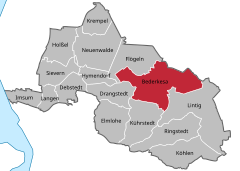Bad Bederkesa
| Bad Bederkesa | ||
|---|---|---|
| Ortsteil of Geestland | ||

Aerial view with the Lake Bederkesa
|
||
|
||
|
Location of Bad Bederkesa within Geestland
|
||
| Coordinates: 53°37′34″N 08°50′34″E / 53.62611°N 8.84278°ECoordinates: 53°37′34″N 08°50′34″E / 53.62611°N 8.84278°E | ||
| Country | Germany | |
| State | Lower Saxony | |
| District | Cuxhaven | |
| Town | Geestland | |
| Area | ||
| • Total | 43.17 km2 (16.67 sq mi) | |
| Elevation | 9 m (30 ft) | |
| Population (2013-12-31) | ||
| • Total | 5,227 | |
| • Density | 120/km2 (310/sq mi) | |
| Time zone | CET/CEST (UTC+1/+2) | |
| Postal codes | 27624 | |
| Dialling codes | 04745 | |
| Vehicle registration | CUX | |
| Website | www.bad-bederkesa.de | |
Bad Bederkesa is a village and a former municipality in the district of Cuxhaven, in Lower Saxony, Germany. Since 1 January 2015 it is part of the town Geestland. It is situated approximately 20 km northeast of Bremerhaven, and 30 km southeast of Cuxhaven. Bad Bederkesa was the seat of the former Samtgemeinde ("collective municipality") Bederkesa, an administrative division consisting of several component municipalities.
Bad Bederkesa belonged to the Prince-Archbishopric of Bremen (est. as principality of imperial immediacy in 1180). The Knights of Bederkesa, like all the place, had been struck by the plague in 1349/1350, completely extinguishing many knightly family lines. The declining knightly family dropped deep into debt, and – having already sold many a possession – had even pawned half the say in the Bailiwick of Bederkesa (Amt Bederkesa) to the aspiring Mandelsloh family.
They again lost this pawn to the city of Bremen, when in 1381 its troops stopped the three Mandelsloh brothers in their attempt to coin pawns from lending to Prince-Archbishop Albert II into territorial power. The Mandelslohs and other robber barons from the Prince-Bishopric of Verden and the Prince-Archbishopric of Bremen ravaged burghers of the city of Bremen and people in the entire prince-archbishopric.
In 1381 the city's troops successfully ended the brigandage and captured the Castle of Bederkesa and the pertaining bailiwick. Thus Bremen gained its foothold as to uphold peace and order in its forecourt on the lower Weser course. In 1386 the city of Bremen became the liege lord of the noble families, holding the estates of Altluneburg and Elmlohe, before vassals of the Knights of Bederkesa.
...
Wikipedia




